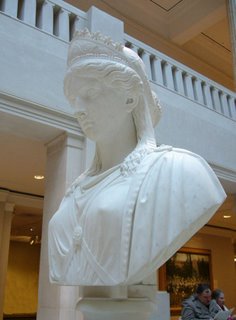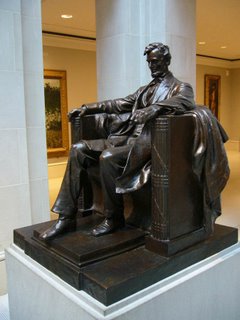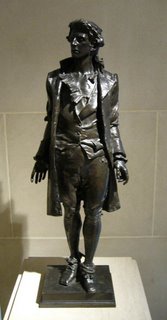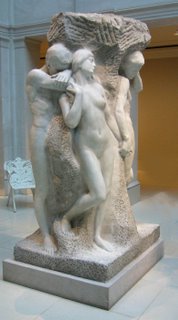19th C. American sculpture at A.I.C.
 Ship's figure-head -- I know a badly near-sighted, very intelligent woman who looks just like this -- eyes half blind but they don't miss a thing -- just like the eyes of a ship should be -- on dark, misty, moonless nights in treacherous waters half way around the world. And you'll notice that since she's now in a museum, she brought her crew home safely with her.
Ship's figure-head -- I know a badly near-sighted, very intelligent woman who looks just like this -- eyes half blind but they don't miss a thing -- just like the eyes of a ship should be -- on dark, misty, moonless nights in treacherous waters half way around the world. And you'll notice that since she's now in a museum, she brought her crew home safely with her. Preacher, c 1830 -- a medieval old-testament prophet --
Preacher, c 1830 -- a medieval old-testament prophet --re-imagined by some back-woods dreamer -- severe but gentle,his mind far, far away in the words of scripture - bound to the service of the lord - I wish the sculptor had carved an entire cathedral - or - maybe he didn't need to.
 Hiram Powers (1805-1873) is an Ohio boy who ended up carving
Hiram Powers (1805-1873) is an Ohio boy who ended up carving marble in Italy. He's classical -- but you'd never mistake him for Greek, Roman,or Renaissance Italian. - the sensuality is only on the surface -- underneath, he's hard as iron. He's a tough but vulnerable American - and I don't really like him - but he has the determination and the skill to do anything.
 Horatio Greenough (1805-1852) is another American who moved to Italy -- and he's got that dreamy, airy idealism that feels more British than American to me. This figure is not human, it's a mathematical formula, ornate, complete, and fully proven -- and it seems to be made out of sugar.
Horatio Greenough (1805-1852) is another American who moved to Italy -- and he's got that dreamy, airy idealism that feels more British than American to me. This figure is not human, it's a mathematical formula, ornate, complete, and fully proven -- and it seems to be made out of sugar.  Harriet Hosmer (1830-1908) I first heard about Harriet while vacationing in the Mississippi river town of Lansing, Iowa -- where a local bluff was given her name after she won a footrace to the top back in good old steamboat days. A tough little woman, she moved to Italy, where there's a cute photograph of her diminutive self surrounded by a dozen, brawny Italian stone cutters. Then later, I heard about this piece when it was discovered in a dump in my current home town of Forest Park Illinois. A hundred years ago, my town
Harriet Hosmer (1830-1908) I first heard about Harriet while vacationing in the Mississippi river town of Lansing, Iowa -- where a local bluff was given her name after she won a footrace to the top back in good old steamboat days. A tough little woman, she moved to Italy, where there's a cute photograph of her diminutive self surrounded by a dozen, brawny Italian stone cutters. Then later, I heard about this piece when it was discovered in a dump in my current home town of Forest Park Illinois. A hundred years ago, my town had a race track where this monumental bust of Queen Zenobia was on display -- but when the race track was demolished (and replaced by a WWII torpedo factory (!)) , Queen Zenobia went into a stone dump in the adjacent cemetary. Ten years ago she got fished out -- cleaned up -- and put on display at the Art Institute. So the old girl has quite a colorful history -- but I still think she belongs in some kind of amusement park -- maybe a casino in Vegas ? or a museum of contemporary art ? Harriet Hosmer was an early conceptualist.
 Daniel Chester French (1850-1931) The "dean of American sculptors" - and I suppose the most fluid practitioner of the beaux arts style in America -- buoyant, dramatic,important -- but not quite profound -- again, just a little too much like mannekins on a stage instead of sculpture in a temple -- witness his "Lincoln" (1916), which just comes off to me as puppetry for a parade -- rather than the dignity that a sculptor like Houdon could give to George Washington. The center of this piece is emptiness -- which would not be a problem if it were only intended as a float for Mardi Gras.
Daniel Chester French (1850-1931) The "dean of American sculptors" - and I suppose the most fluid practitioner of the beaux arts style in America -- buoyant, dramatic,important -- but not quite profound -- again, just a little too much like mannekins on a stage instead of sculpture in a temple -- witness his "Lincoln" (1916), which just comes off to me as puppetry for a parade -- rather than the dignity that a sculptor like Houdon could give to George Washington. The center of this piece is emptiness -- which would not be a problem if it were only intended as a float for Mardi Gras.  Look at the detail of Lincoln's head -- if ever nature made a head for dramatic sculpture, ugly old Lincoln had one. But French has normalized and aestheticized it -- I suppose so as not to frighten school children and their matronly teachers.
Look at the detail of Lincoln's head -- if ever nature made a head for dramatic sculpture, ugly old Lincoln had one. But French has normalized and aestheticized it -- I suppose so as not to frighten school children and their matronly teachers.  Frederick MacMonnies ( 1863-1937) -- After 1860, American sculptors adopted the naturalism and dramatic surface of the Beaux Arts program, but Nathan Hale (1890) is less like mythology and more like an editorial cartoon found on an op-ed page of a newspaper. Compare this bound-victim with Rodin's "Burghers of Calais" . Whatever else might be said, this one is certainly more sexy : The cute face, pouting lips, bare chest, dischevelled frillery, innocent look, and the arms helplessly tied to his side.
Frederick MacMonnies ( 1863-1937) -- After 1860, American sculptors adopted the naturalism and dramatic surface of the Beaux Arts program, but Nathan Hale (1890) is less like mythology and more like an editorial cartoon found on an op-ed page of a newspaper. Compare this bound-victim with Rodin's "Burghers of Calais" . Whatever else might be said, this one is certainly more sexy : The cute face, pouting lips, bare chest, dischevelled frillery, innocent look, and the arms helplessly tied to his side.  Laredo Taft (1860-1936) - I'm sweet on Laredo Taft because legend has it that his students are responsible for beginning my art club, the Palette and Chisel. He's down-home kind of guy -- Illinois native born to free-thinking parents with a penchant for colorful names. He went to Paris and became
Laredo Taft (1860-1936) - I'm sweet on Laredo Taft because legend has it that his students are responsible for beginning my art club, the Palette and Chisel. He's down-home kind of guy -- Illinois native born to free-thinking parents with a penchant for colorful names. He went to Paris and becamea beaux-arts sculptor. But what's wrong with that school is what's wrong with him: he makes tableaux, not sculpture -- so all the dramatic elements are there and the actors are well made and dramatically posed --- but the inner life of form has eluded him. Maybe formal resolution is innappropriate to the subject here --"Solitude of the Soul" - where each actor -- and each form -- should be lonely and apart. Maybe this makes him another early conceptualist -- but compare this piece with George Gray Bernard's contemporary monumental marble at the Met -- and I'm afraid we see why Taft's reputation has not traveled far from the 'second city'.


0 Comments:
Post a Comment
<< Home